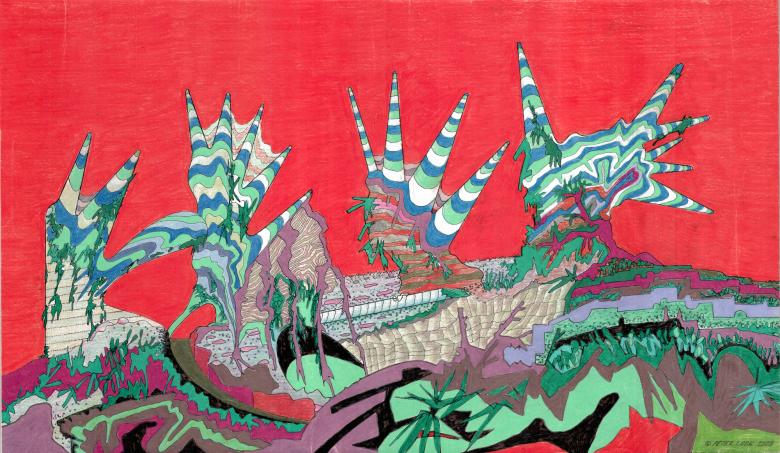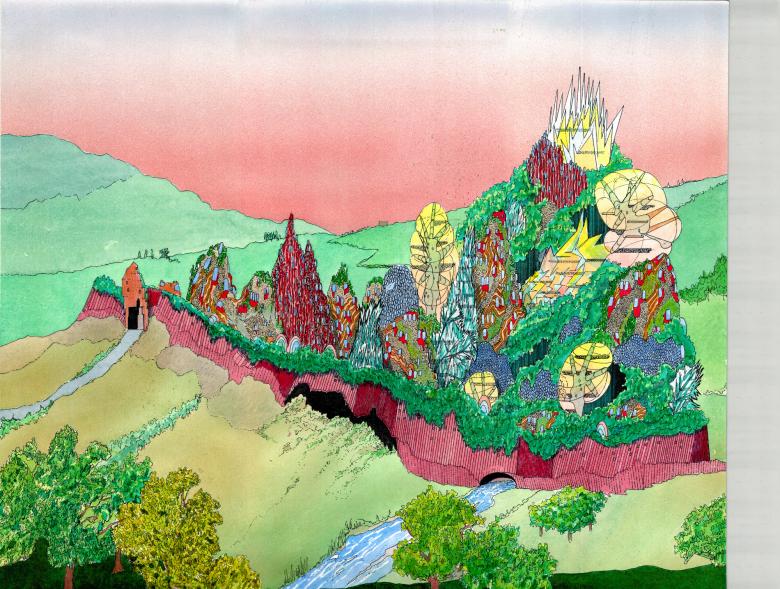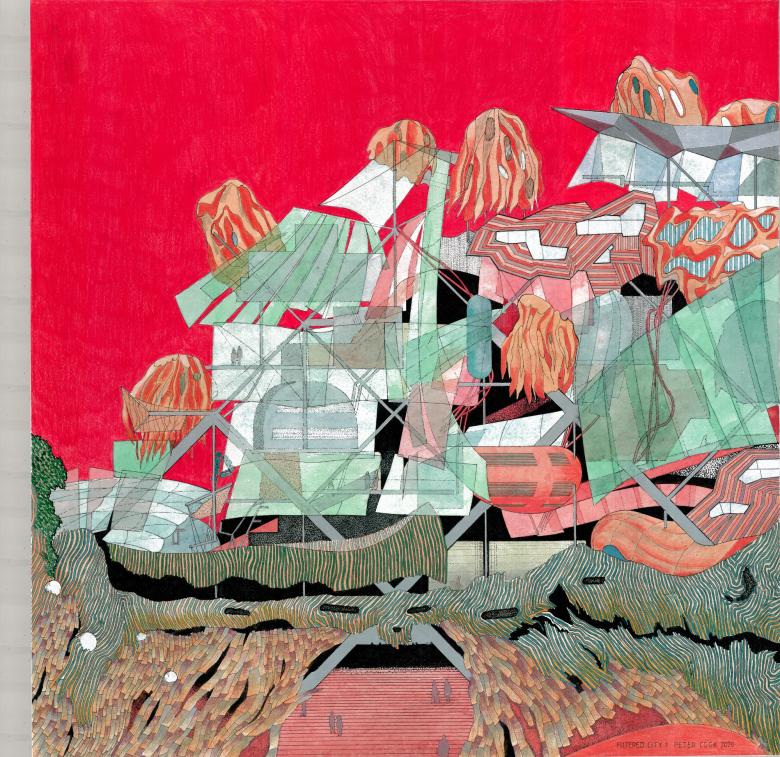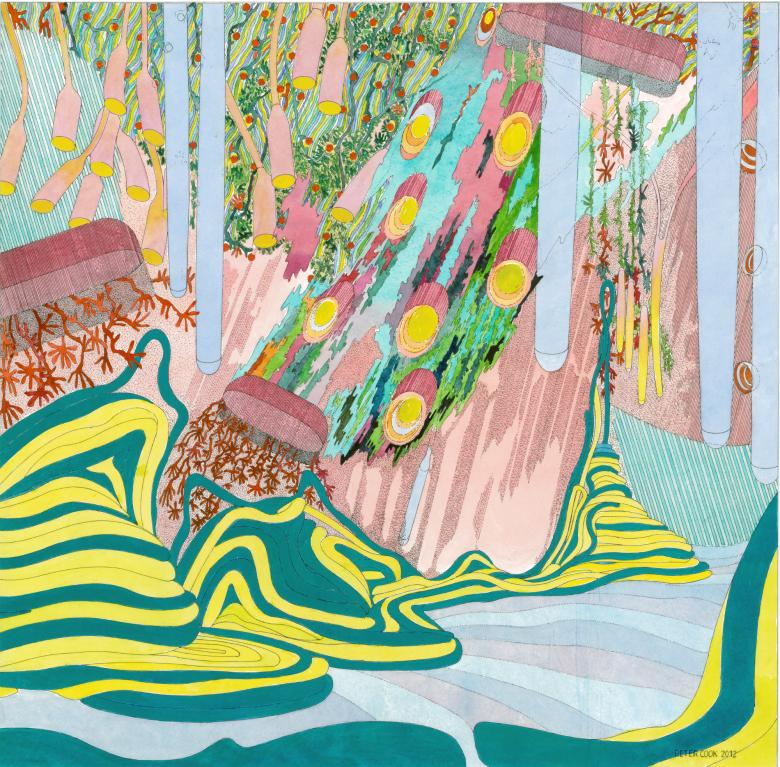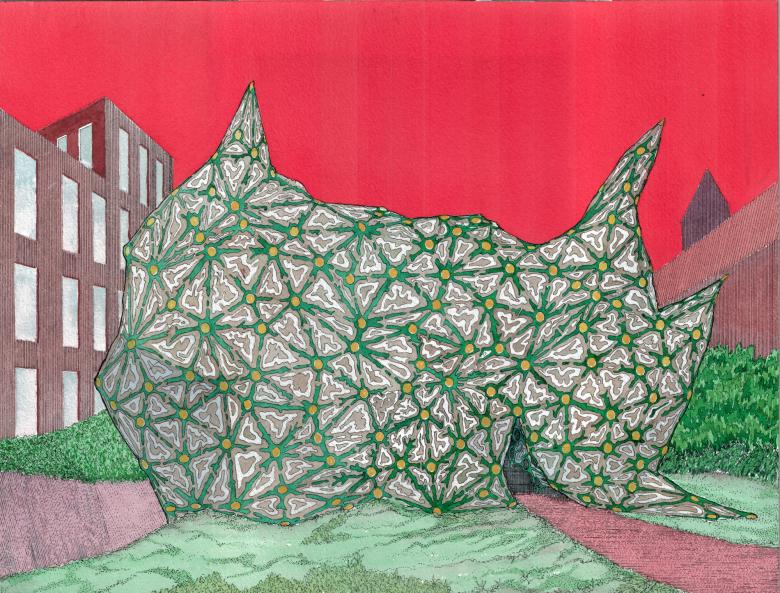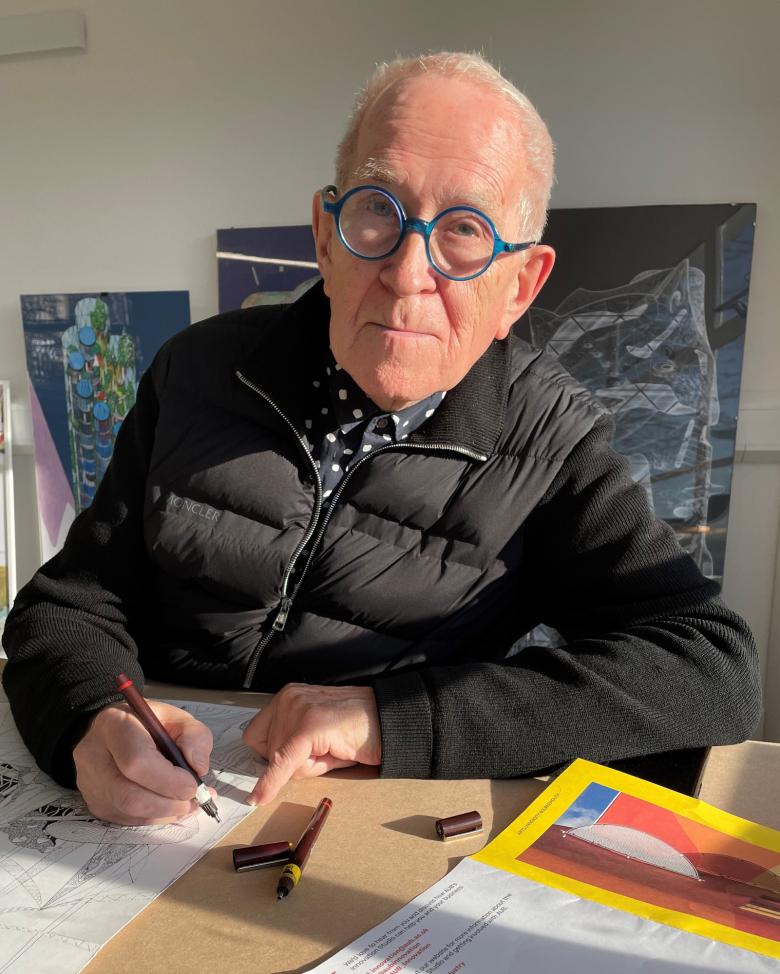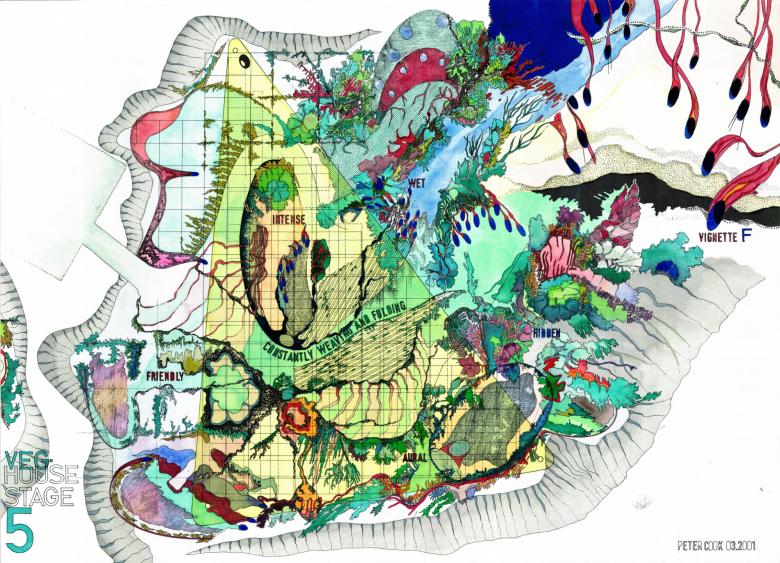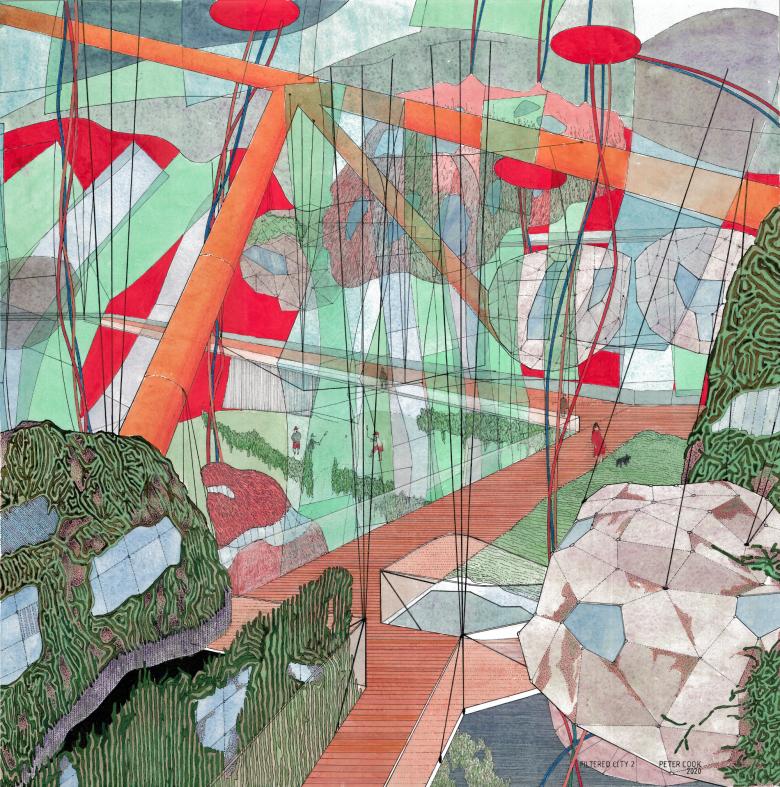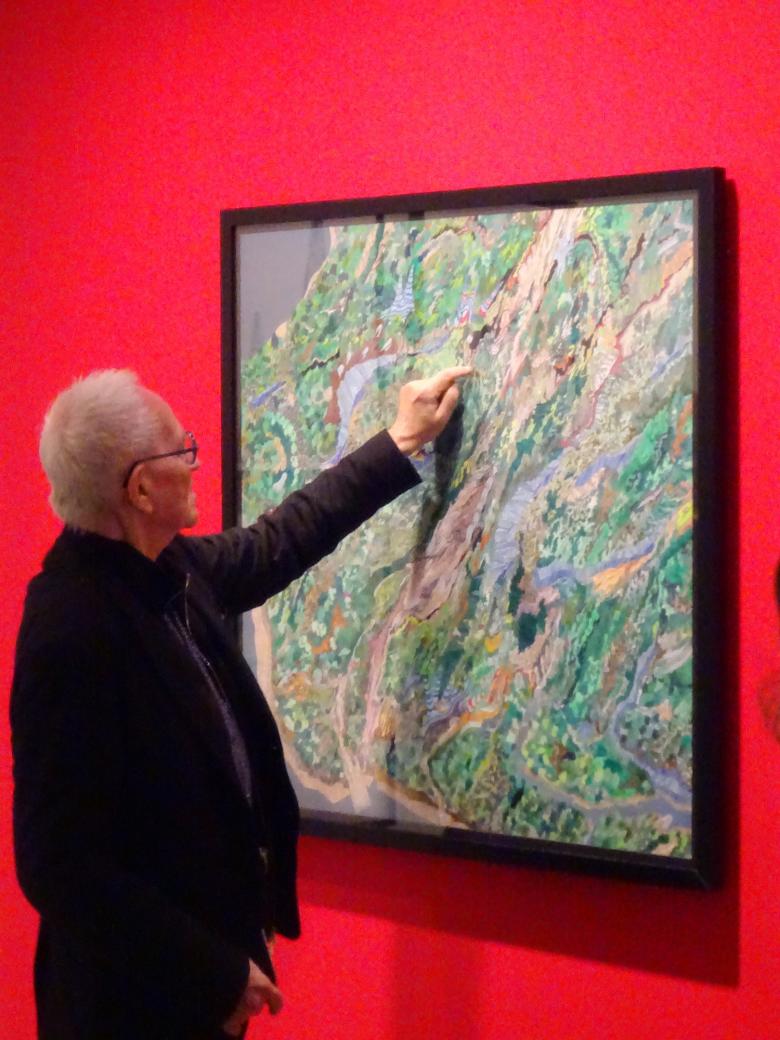Peter Cook's City Landscapes
A big Peter Cook retrospective is now on display at the Louisiana Museum of Modern Art in Humlebæk, Denmark. Peter Cook – City Landscapes opened on January 21, with the famed architect and founding member of Archigram in attendance. Ulf Meyer filed this report and spoke with Cook.
British Pop architect Peter Cook, a living legend who is unstoppable even well over 80 years old, has influenced architecture for over six decades with his ideas about cities. The Louisiana Museum of Modern Art, located on the coast north of Copenhagen, features the founding member of Archigram in a big monographic show, Peter Cook – City Landscapes, that shows his work in drawings only — no models, no photographs. The graphic work — starting from Yellow Submarine-like drawings from the 1960s all the way to the recent “Tuscan Hilltop Town” and “Filter City” series (both 2020) — illustrate how he is postmodernism’s most famous architectural graphic designer.
Such built projects as the Kunsthaus in Graz, Austria’s second city, are barely mentioned; they pale in comparison to the drawings that aim “to shake up conventional notions of cities” and are “free from the demands and obligations of solutions and materials.” The exhibition is structured chronologically, interrupted by the theme of utopian “Towers,” his favorite typology. Some drawings were submitted to design competitions – but of course they did not win. All drawings are part of Cook's collection, though he has started to unlock their commercial value by printing select motives for the art market.
His most recent collage-like drawings still feature new ways of filling cities with building elements and people inhabiting the imaginative cityscapes. Though organic, everything is rendered precisely and to scale. The template is often a black and white drawing, copied and colored with watercolors, pencils, or gouache. Little has changed since the Sixties, when Plug-in, Walking and Instant Cities were the talk of the town in architectural circles worldwide. The curator of the exhibition, Louisiana's Kjeld Kjeldsen, let Cook largely design his own show.
Archigram (a portmanteau of "architecture” and “telegram") has been telling the same story since 1968: technology is a promise; city and place are unimportant; space travel is cool; and architecture is boring. It becomes clear how far today's architecture has strayed from these axioms when one sees Cook's “quotational” city fantasies of underwater cities and living cells neatly framed in the museum. Cook's experiments were groundbreaking in the "Vegetated Lump" series, which tells of the merging of architecture and vegetation and organically merges nature into architecture.
Little of this comes through in Cook's built architecture, where there is no theoretical edifice. For the Graz Kunsthaus he needed Colin Fourier; for the Architecture School in Queensland Gavin Robotham; and his mediocre apartment building on Berlin's Lützowplatz (with Christine Harley) no longer appears in his CV. In it, Cook the architectural graphic artist, who was knighted by the Queen in 2007, is described as a “teacher, artist, utopian.”
Cook has dedicated his life to the "importance of being silly." In Scandinavia, “where people are organized, I can be exotic,” he said at the opening of City Landscapes. His lifetime achievements include nine buildings built, hundreds of drawings drawn, and thousands of students instructed; he also has written eleven books, “but never a single footnote.” While his name is eternally connected to Archigram and London’s Swinging Sixties, he confessed that he “never took drugs." At the time, he "had a wife and listened to Sibelius.”
Ulf Meyer: You must be a happy man today.
Peter Cook: This is the best show I have ever had. It is well lighted and well hung and comprehensive.
You were involved in the design of the show. Did you co-curate yourself?
Not really, but I have hung many shows. A Danish PhD student of mine has helped me. But these guys at Louisiana are great, too.
Was it Kjeld Kjeldsen personally, who put the show together?
Yes, together with my wife.
Is there an archive in London of your work from which you picked some cherries? Are we missing any major parts?
There should be one, but the works are all over the place. Some drawings are in the MoMA in New York, some are in the DAM in Frankfurt and the Pompidou in Paris. I sold sixty prints this year, so now I have a tax problem! Especially the “Filter City” series sold well. Now, I would like to do some print runs of older drawings, too.
The Museum for Architectural Drawing in Berlin, in its exhibition on Mark Fisher and StuFish, claims that the ideas of Archigram survived (only) in stage design.
I am rather pleased about that claim. Mark Fisher was my student.
The Nagakin Capsule Tower in Tokyo will be knocked down, soon, unfortunately. Does this mark the end of an era in architecture that you shaped when you were young, when you think of the Plug-in City and metabolism?
Who is the chicken and who is the egg? We looked at magazines about Japanese architecture in in the 1960s and I met Kisho Kurokawa several times, but I was closer to Arata Isozaki. We ran a class in LA together (with Ron Herron). He invited me to his house together with Toyo Ito and Itsuko Hasegawa and others in 1979. They were from a younger generation and no rivals. Later Kazuyo Sejima worked with Tom Heneghan and she was friendly to me because I chaired a jury that gave her a commission.
Urban design does not quite exist in Japan. Is something stopping you from participating in urban design competitions?
I tried to get involved in urban design, but the competitions seem to be full of tabulators, I prefer ideas. I am participating in a paid-for competition in Saudi-Arabia for a village. I also participated in competitions in Gold Coast and near Perth in Australia. I just haven’t broken through yet! But I have not done that many buildings either. I only have buildings in Madrid, Vienna, Graz, two in Bournemouth, and one in Berlin.
On Feb 24th you will come back to Louisiana to give a lecture. What will it be about?
It will be about the exhibition and I’ll break it down into projects and talk about projects from the exhibition.
I already have ideas for several new drawings. I would like to do more about skin and surface and what can be seen “between” and “through,” like filters and screens. What is the concentrated or primary object and what is the chorus? Sometimes you get it right and sometimes you get it wrong.
Thank you for the interview!
Peter Cook – City Landscapes is on display at Louisiana Museum of Modern Art in Humlebæk, Denmark, from January 21 to May 8, 2022.
